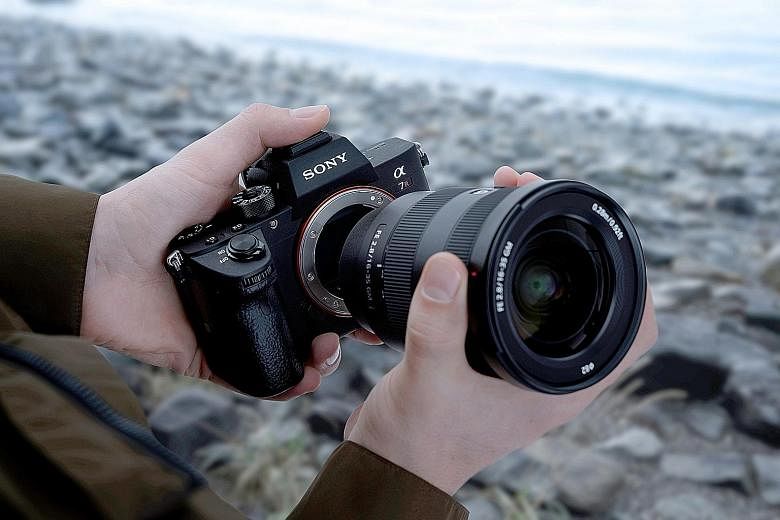The a7R III is the latest full-frame interchangeable-lens, mirrorless camera from Sony, arriving just months after the launch of the company's excellent a9, also a full-frame mirrorless unit with interchangeable lens.
Unlike the whopping 20 frames per sec (fps) shooting speed of the a9, the a7R III has a more modest 10fps shooting speed. However, its 42.4-megapixel image sensor dwarfsthe a9's 24.2-megapixel sensor in resolution.
The a7R III succeeds the a7R II, which was launched in 2015. It has the same megapixel count as its predecessor, but comes with other improvements. Its 10fps shooting speed is twice as fast as the Mark II.
Plus, the a7R III uses a hybrid autofocusing (AF) system comprising 399 focal-plane phase-detection AF points and 425 contrast-detection AF points. For this review, the a7R III is used with Sony's 24-70mm f/4.0 FE lens and Sigma's new 16mm f/1.4 DC DN lens.
The a7R III looks almost exactly like its predecessor. It still feels solid and sturdy, thanks to its magnesium alloy chassis. It has a pronounced rubberised grip and a contoured rear thumb rest that allows for a more secure hold on the camera.
On the side of the grip, there is a compartment for dual SD card slots. But only one slot supports the faster UHS-II format.
Button layout, already well thought out and intuitive to use in its predecessor, gets better in the Mark III. The top layout remains relatively the same, while the rear layout gets more changes.

On the camera's top right, there are now two customisable function buttons to accompany the mode dial and the exposure compensation dial. The shutter release sits atop the grip instead of on the right of the body.
There is a command dial in front of the grip, where the index finger usually rests. A rubberised rear command dial sits near the thumb rest.
The dedicated video-recording button - previously sited awkwardly on the wrong side of the thumb rest and is closer to the grip instead - has been moved inwards, to the right of the electronic viewfinder.
This makes it much easier to press when you want to record videos.
A new joystick, sited just above the rear command dial, allows you to move the AF point quickly.
-
TECH SPECS
PRICE: $4,699 (body only)
IMAGE SENSOR: 42.4-megapixel full-frame Exmor CMOS
SCREEN: 3-inch tiltable touchscreen LCD with 1,440,000 dots; electronic viewfinder with 3,686,400 dots
SENSITIVITY: ISO 50 to 102,400
SHOOTING SPEED: Up to 10 frames per second
CONNECTIVITY: Wi-Fi, Near Field Communication and Ethernet
WEIGHT: 657g (body only, with battery and memory card)
RATING
FEATURES: 5/5
DESIGN: 5/5
PERFORMANCE: 5/5
BATTERY LIFE: 4/5
VALUE FOR MONEY: 5/5
OVERALL: 5/5
The LCD is now touchscreen and supports the Touch Pad function, which allows you to drag the AF point with your finger on the LCD when you compose your shots through the viewfinder.
With its intuitive layout, new AF joystick and sturdy body, the handling of the a7R III is second to none. It starts up in 1.3sec and shuts down in 1.1sec - much faster than most mirrorless cameras.
Using an SD card with a writing speed rated at 95MB per second, it was able to shoot 88 RAW images in 10.8sec before the buffer ran out. That is simply amazing performance for a mirrorless camera.
The a7R III achieves focus lock effortlessly and instantaneously in bright sunlight. In dim lighting conditions, it takes at most only 1sec to secure a focus with the aid of the AF assist light.
Image quality is simply wonderful, with sharp rendition of pixels and vibrant colours. The amount of details I got from this camera is just incredible and eye-popping. This camera is ideal for portrait, product and wedding photography.
Noise performance is equally stellar. Image noise is non-existent until ISO 3,200. At ISO 6,400, detail loss was more evident. But even at ISO 12,800, images were still good enough for posting on Instagram or Facebook. However, images shot above ISO 12,800 looked washed out, with distinct detail loss.
The a7R III's battery life has improved greatly from its predecessor's. A full charge is good for around 550 still images, compared with a mere 300 shots with the Mark II.
For some, the a7R III's price tag of $4,699 (body only) might seem expensive but, given its performance, I think it is superb value for money.
•Verdict: The Sony a7R III is an amazing camera with superb handling and build, and hits the sweet spot between high-resolution images and fast shooting.


